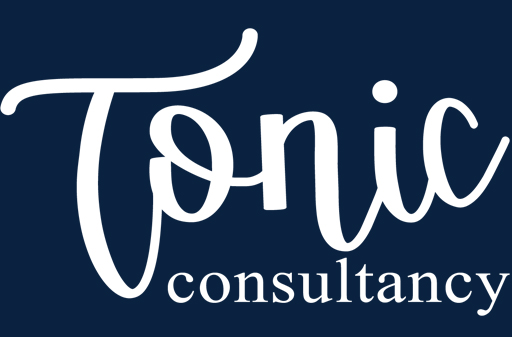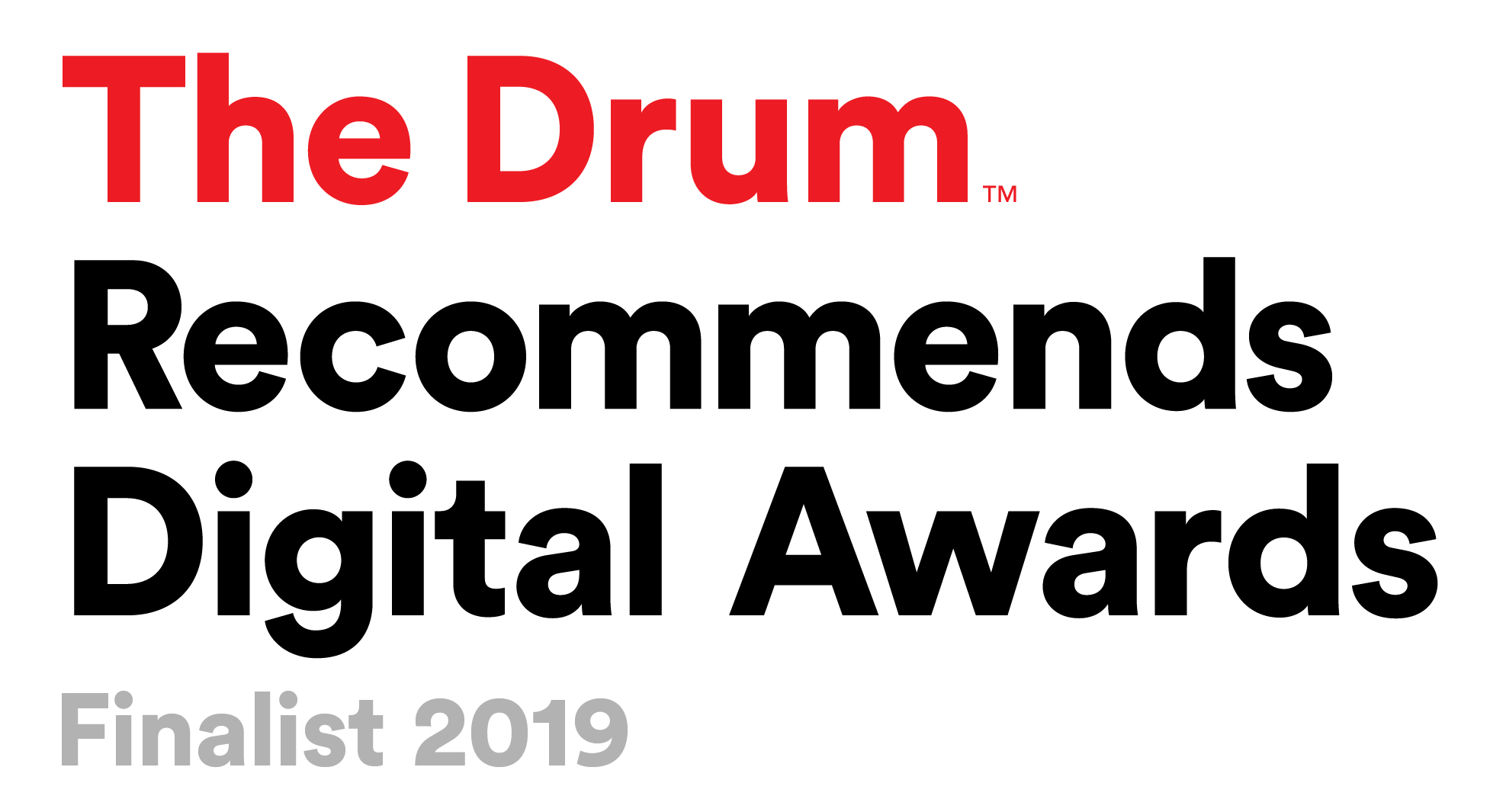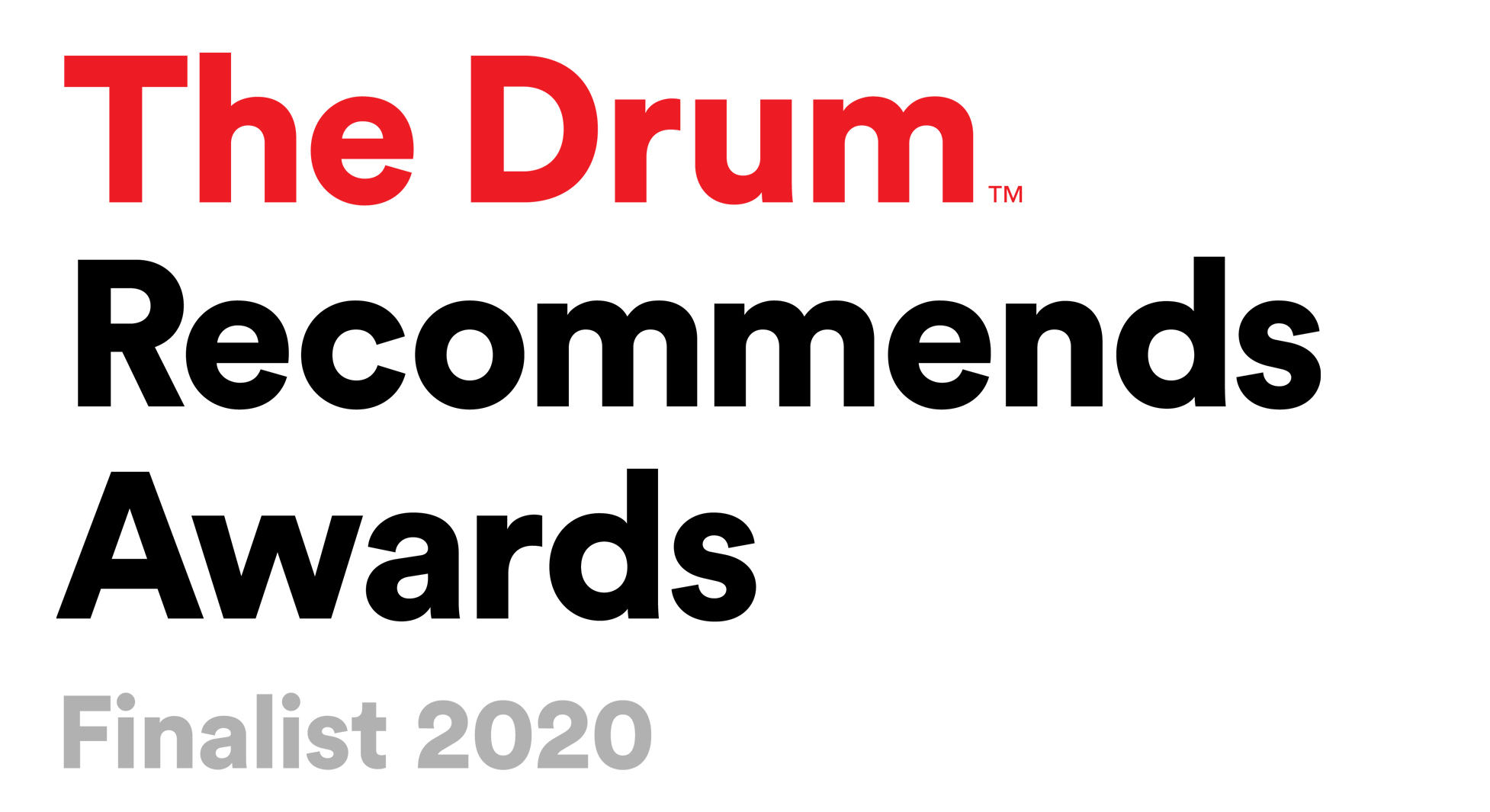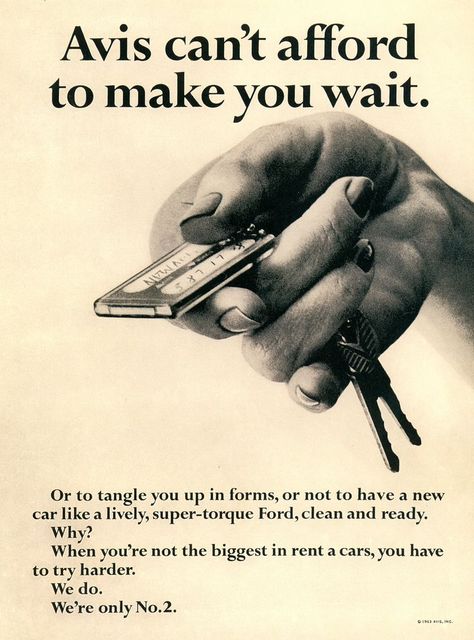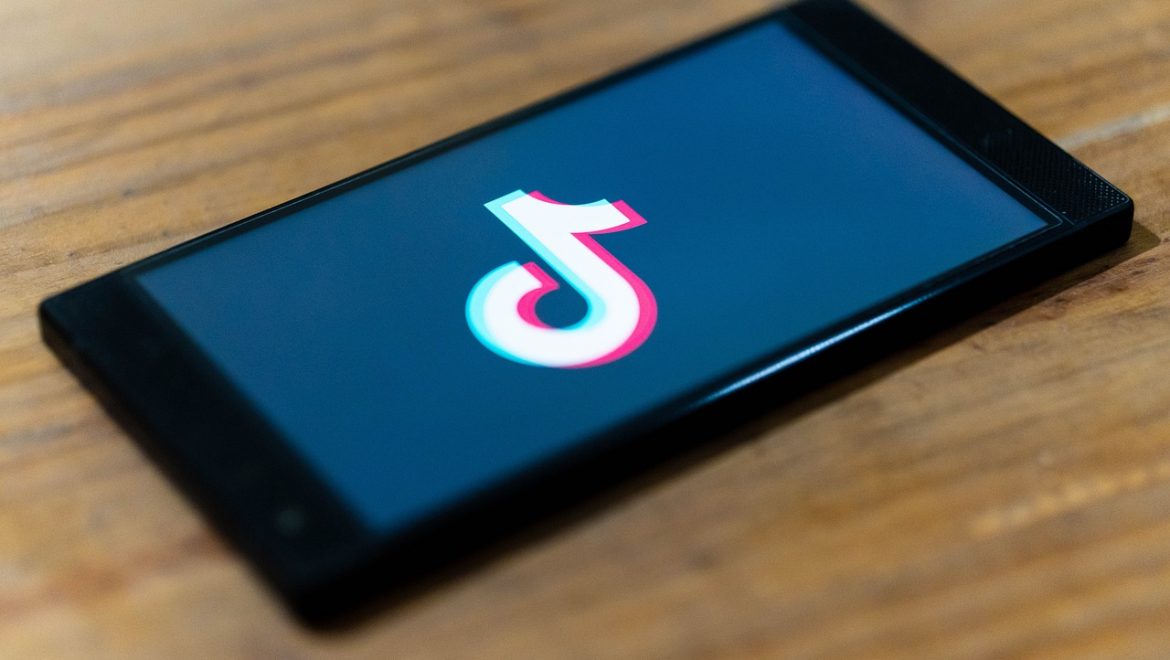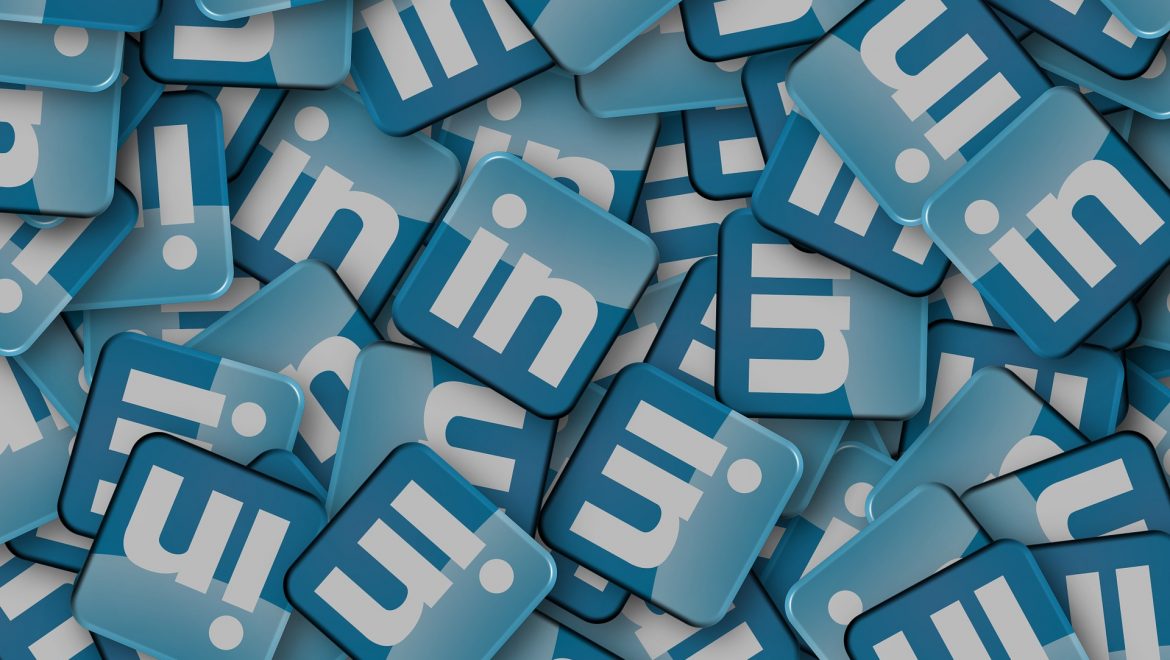Avis’ “We Try Harder”: Branding For Underdogs
It must be easy when you’re at the top. Those big companies have household brand names, with instant recognition, even with just their logo. The three stripes of Adidas. The silhouette of an apple with a bite out of it? Obviously Apple. The golden double arches of McDonald’s. The list goes on and on.
These multinational firms have the marketing budgets to hire the biggest and best advertising and marketing executives, placing their flashy, expensive ads in prime positions and prime-time TV slots.
But what if you’re not number one? How do you compete with these gargantuan companies?
It’s something that car rental firm Avis needed to consider back in the early 1960s and became a masterclass in humblebrag marketing. We wanted to take a look at the story of what happened and see what lessons can be learned, and how to turn being an underdog to your advantage.
We’re Number Two!
Avis is one of the oldest and most well-known car rental companies in the world, but in the early 1960s, they were seriously lagging behind their major competitor Hertz.
Avis and Hertz had a rivalry that dated back to the 1940s when US Air Force officer Warren Avis spotted an unexpected opportunity for the car rental industry as he travelled around America. What if he put car rental offices inside airports?
At this time, most car rental firm locations, including Hertz were in the downtown areas of cities, but Avis thought it would appeal to the ever-growing numbers of business travellers who wanted to fly into cities, drive to meetings, and be able to drive back and fly out the same day.
“Even as we grew by leaps and bounds, the Hertz people vowed up and down that our approach wouldn’t work,” Avis recalled in his 1986 autobiography, Take a Chance to Be First. However, that all changed. “They jumped in and began to copy everything that we had pioneered. I honestly don’t think that Hertz has come up with an original idea yet in the airport car rental field.”
In 1962, Robert C. Townsend, the president of Avis began looking for ways to increase the company’s market share, starting by hiring famed Madison Avenue ad men Doyle Dane Bernbach.
What did Avis have that could set it apart? Newer cars than Hertz? More rental locations? Lower rates? No, none of that.
DDB spent months learning all about Avis’ business by interviewing employees, and reduced their research down to one question – Why would anyone want to hire a car from the number two rental agency?
The answer became a world-famous ad slogan: We Try Harder.
Instead of putting all the focus of the new campaign into claiming to be the best or undermining the competition, DBB highlighted Avis’ position as the second-best car rental firm, and as such, knew it always tried harder, strongly implying that the number one firm Hertz was resting on its laurels, too big to care about its customers.
The ads cleverly played on the fact that Avis was not the biggest in the world, but it was determined to be the best, always striving to provide the best service and value to its customers.
Taking A Risk
The idea of promoting a brand’s weakness would have been a most unthinkable tactic for the ad men of Madison Avenue. Why on earth ask customers to think about why you’re the runner-up? It seemed more logical to project unflappable confidence in your business.
It was DBB copywriter Paula Green, a real-life Mad Men Peggy Olsen, who devised the ‘When you’re only No. 2’ tagline, which was a revolutionary move, and as she later said in interviews, “It went against the notion that you had to brag.” Green also said, likely in reference to her workplace obstacles, that “We Try Harder” was also the story of her life.
According to famed ad man David Ogilvy, the ‘Father of Advertising’, Green’s ads were a feat of ‘diabolical positioning’, and DBB became the masters of the humblebrag advertising campaign.
While American cars were being marketed with massive flashy campaigns – much like the cars themselves – DBB pitched a now legendary 1961 print ad for the Volkswagen Beetle. The copy simply stated ‘Think Small’ and featured a tiny image of the car floating in an expanse of white space. Another ad stated ‘It’s ugly but it gets you there’.
DBB seized up the cultural moment, as Americans were becoming weary of the bigger-is-better, 1950s consumerism, and were receptive to a humble message that threw shade at authority.
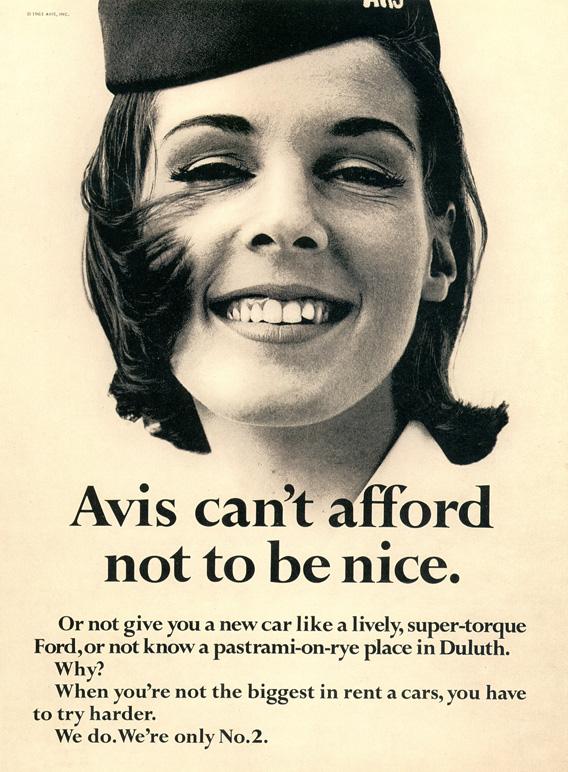
We Try Harder
Hertz made a point of ignoring Avis’ campaign, likely furthering the notion that they were too big to care. However, they couldn’t ignore the fact that the company’s market share dropped from 61 to 49 per cent. Meanwhile, the market share for Avis grew from 29 to 36 per cent.
By 1966, Hertz fired back, with a series of ads wanting to explain why they were (still) number one. But the damage had been done, and Avis had considerably closed the gap on their competition.
While Avis dropped the ‘We Try Harder’ slogan in 2012, 60 years after it was coined, the company still retains that ethic and has been an innovator in the car rental industry, such as being the first company to introduce computerised reservations, the first company to introduce a frequent-renter program, and the first to offer a wide variety of speciality vehicles, like luxury cars, SUVs and vans.

Underdog Brand Biography
Green’s campaign established what is now known as an underdog brand biography, a rhetorical device used by marketers to chronicle a brand’s humble origins and life experiences, its evolution, its hopes and dreams, and noble strategies against adversaries.
It’s a strategy used by many companies since, such as the, albeit apocryphal, Apple ‘We started in a garage’ story, or Adidas’ ‘Impossible is Nothing’ campaign telling the story of a ‘simple shoemaker from a small town.’
So what is your underdog brand biography? Can not being the top dog help you find a way to better market your brand?
Why not come and talk to the team at Tonic? We’re not number one, but we always try harder.
